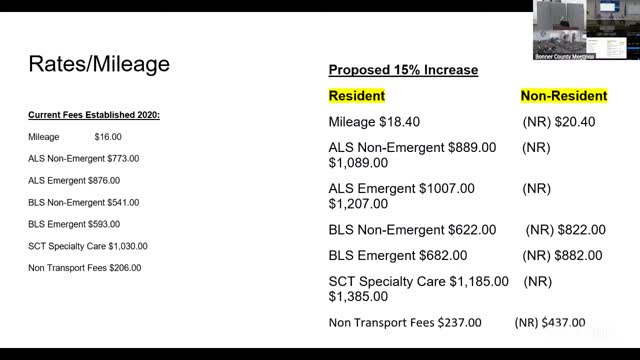
This article was created by AI using a video recording of the meeting. It summarizes the key points discussed, but for full details and context, please refer to the video of the full meeting. Link to Full Meeting
Key discussions centered around the metrics used to assess the ambulance service's viability, including the number of paramedics and EMTs relative to the population. Officials referenced Canyon County as a benchmark, noting its larger population and established practices that Bonner County might emulate as it anticipates similar growth. The conversation also included comparisons with Nez Perce County, which has a population size more akin to Bonner County, to better understand cost structures and service demands.
A significant point raised was the necessity of a sustainable funding model for the ambulance district. Current proposals suggest a fee increase of 15%, but some commissioners expressed concerns that this may not be sufficient to cover rising operational costs, particularly personnel expenses. The discussion highlighted that many neighboring counties have implemented levies to support their ambulance services, a strategy Bonner County has yet to adopt.
Commissioners emphasized the importance of data-driven decision-making. One commissioner noted the need for thorough research into the financial health and operational metrics of other ambulance districts before committing to any fee increases. This sentiment was echoed by another commissioner, who argued against arbitrary percentage increases without a solid understanding of the underlying costs and service needs.
The meeting also introduced a new nonresident fee, aimed at addressing the influx of tourists who utilize local EMS services. This fee structure is seen as a necessary step to ensure that the financial burden of providing emergency services does not fall solely on local residents.
As the discussion concluded, it became clear that while there is a consensus on the need for fee adjustments, the exact percentage and structure remain contentious. The commissioners agreed to further investigate the financial models of other ambulance districts to inform their next steps, ensuring that any changes made will be sustainable and reflective of the community's needs. The outcome of these discussions will be crucial for the future of Bonner County's EMS services, as officials strive to balance fiscal responsibility with the provision of essential emergency care.
Converted from Hearing - EMS Fee Increases meeting on April 09, 2025
Link to Full Meeting
Comments
View full meeting
This article is based on a recent meeting—watch the full video and explore the complete transcript for deeper insights into the discussion.
View full meeting